Papers by Chiara Gianollo
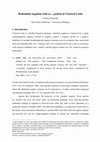
Festschrift in honour of Cecilia Poletto's 60th birthday, Volume 2, QUADERNI DI LAVORO ASIT 25, 541 - 570, http://asit.maldura.unipd.it/documenti/ql25/4_QLASIt25.pdf, 2023
Classical Latin is a Double Negation language: sentential negation is expressed by a single morph... more Classical Latin is a Double Negation language: sentential negation is expressed by a single morphologically negative element (a negative marker, a negative adverb or a negative indefinite); if multiple morphologically negative elements occur in a sentence, they cancel each other out. In Early and Classical Latin, exceptions to this general system are very rare (Ernout and Thomas 1953: 154–155, Molinelli 1988), and typically justified as particularly emphatic statements, where the additional negative element can be analyzed as a weakly syntactically integrated afterthought (Orlandini 2001: 67–72; Gianollo 2018: 189–191). Against this background, the behavior of the complex negative focus particle ne...quidem ‘not even, not either’ poses an interesting challenge, since with this particle redundant marking of negation is observed more often and, what is more important, in a systematic fashion. In this work I study ne...quidem in a corpus of Classical Latin and I propose an analysis connecting formal redundancy to the syntax of focus in Classical Latin: specifically, I analyze patterns of redundancy in terms of movement-mediated doubling, following Poletto (2008), and I attribute their existence to the interaction between the syntax of negation and focus. Moreover, I argue that these Latin patterns may have played a role in the development of Romance Negative Concord.
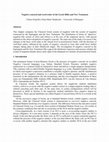
pre-print; published in Postclassical Greek Problems and Perspectives, Edited by Giuseppina di Bartolo and Daniel Kölligan, 2024
This chapter compares the Classical Greek system of negation with the system of negation witnesse... more This chapter compares the Classical Greek system of negation with the system of negation witnessed by the Septuagint and the New Testament. The distribution of forms of ‘objective’ negation (the system of οὐ(κ) and οὐδείς) is at the core of the empirical survey, with special attention to the observed patterns of negative concord. The main aim of the study is to assess if the changes in the basic word order at the clausal level in postclassical Greek, with the decrease of verb-final orders, influenced the syntax of negative concord in ways that could favor further changes taking place at later (Medieval) stages. The investigation of negative concord in the Septuagint and the New Testament fills a gap in the diachronic trajectory and assesses whether the system of negation already shows early signs of development in (varieties of) postclassical Greek.
Paths through meaning and form: Festschrift offered to Klaus von Heusinger on the occasion of his 60th birthday, 2022
In contemporary Italian it is possible to find the preposition 'salvo' with two apparently contra... more In contemporary Italian it is possible to find the preposition 'salvo' with two apparently contrasting meanings: ‘except’ and ‘provided’, ‘subject to’. That is, the same element can introduce a negative or a positive condition. Speakers are aware of this apparent ambiguity and consciously react to it, showing that the process has reached a diachronic tipping point. I try to reconstruct how this point was reached, and show that the exceptive use, which is nowadays prevalent, arose as an innovation in the diachronic development from Latin to Italian, whereas the ‘provided’ meaning combines a conservative semantics with an innovative form. The case of Italian 'salvo' is yet another witness to the theoretical and diachronic interest of exceptive constructions.
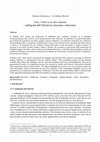
Chiara Gianollo & Caterina Mauri, 2020. Uno, l’altro e un altro ancora: ambiguità dell’alterità tra sincronia e diacronia «QUADERNI DI SEMANTICA», 2020, Special Issue, pp. 131 - 174. , 2020
In italiano, altro mostra una dimensione di ambiguità poco esplorata, secondo cui si distingue
un... more In italiano, altro mostra una dimensione di ambiguità poco esplorata, secondo cui si distingue
un’interpretazione come ‘diverso’ da un’interpretazione come ‘ulteriore’. Il contributo si occupa di individuare
gli elementi del significato che danno origine a questa ambiguità e le condizioni contestuali che conducono
alla disambiguazione. La questione è affrontata per mezzo di un confronto tra la situazione del latino arcaico
e classico e la situazione che per l’italiano emerge dall’analisi di dati del parlato. L’analisi evidenzia la
presenza di un nucleo di tratti comuni a latino e italiano, che corrobora la pervasività della dimensione di
ambiguità oggetto di studio e pone le basi per un’indagine diacronica. I dati del parlato permettono, inoltre, di
studiare nel dettaglio i meccanismi inferenziali che mettono gli interlocutori in grado di gestire l’ambiguità e
di risolverla nel contesto.
In Italian, altro ‘other’ shows a dimension of ambiguity that has been little explored, according to which the
reading ‘different’ is distinguished from the reading ‘further’. This contribution singles out the meaning
elements that produce this ambiguity and the contextual conditions that lead to disambiguation. The issue is
approached by means of a comparison between the situation in Archaic and Classical Latin and the situation
that emerges from data of spoken Italian. The analysis highlights the presence of a core of features shared by
Latin and Italian, which corroborates the pervasive character of the investigated ambiguity and lays the
groundwork for a diachronic investigation. Furthermore, the data from spoken Italian enable a detailed study
of the inferential mechanisms that allow the speakers to manage ambiguity and resolve it in context.
In C. Gianollo, K. von Heusinger & M. Napoli (eds.), Determiners and Quantifiers: Functions, Variation, and Change. Syntax and Semantics Series. Brill, Leiden: 1-28, 2022
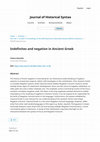
OPEN ACCESS DOWNLOAD ON https://ojs.ub.uni-konstanz.de/hs/index.php/hs/article/view/46
The histo... more OPEN ACCESS DOWNLOAD ON https://ojs.ub.uni-konstanz.de/hs/index.php/hs/article/view/46
The history of Greek negation is interesting for our theoretical understanding of negation systems in at least two respects, which I will investigate in this contribution. First, Homeric Greek is a Double Negation system, while Classical Greek exhibits Negative Concord.
Homeric Greek already shows signs of a diachronic development: there are two series of negative indefinites, an older plain one and a newer emphatic one. The emphatic series is formed by means of the focus-sensitive correlative negation oudé. The latter is the only negatively marked element to exhibit redundancy in the marking of negation in Homeric Greek: it can be argued to be responsible for the birth of Negative Concord items in the language. Furthermore, the system exhibited by Classical Greek is very relevant for our understanding of the syntactic factors that shape Negative Concord. Classical Greek is a non-strict Negative Concord language. However, differently from other well-studied languages of this type (e.g. Italian, Spanish, Portuguese), it shows extremely frequent cases of pre-Infl Concord among multiple Negative Concord items, a more constrained option in Romance. A study of their distribution may help shed light on the interaction between the syntax of Focus and Negative Concord.

La classe plurilingue, 2020
OPEN ACCESS - FREE DOWNLOAD ON PUBLISHER'S WEBSITE: https://buponline.com/prodotto/la-classe-plur... more OPEN ACCESS - FREE DOWNLOAD ON PUBLISHER'S WEBSITE: https://buponline.com/prodotto/la-classe-plurilingue/
Sempre più bambine e bambini, ragazze e ragazzi che frequentano la scuola italiana provengono da famiglie plurilingui; ciò significa che, nella loro quotidianità, si trovano a parlare e a interagire in altre lingue oltre all'italiano. Queste lingue non sempre trovano un adeguato spazio nella vita scolastica, dove talvolta vengono percepite come un ostacolo invece che come una risorsa. In realtà, il plurilinguismo, se adeguatamente compreso e valorizzato, rappresenta una grande ricchezza non solo per i singoli individui, ma anche per l'intera classe: l'importante è che le diverse lingue possano trovare un ambiente favorevole allo scambio e alla conoscenza reciproca. Questo volume ha lo scopo di fornire a insegnanti e educatori di persone plurilingui uno strumento per conoscere più da vicino le altre lingue dei loro allievi. Brevi capitoli descrivono le lingue straniere maggiormente parlate nelle scuole italiane, offrendo informazioni sulla loro storia e sulle loro caratteristiche, in un linguaggio accessibile e con frequenti rimandi contrastivi alla struttura dell'italiano. Gli spunti che si possono trarre dai contributi sulle diverse lingue serviranno a progettare non solo attività di potenziamento linguistico individuale per i nuovi arrivati, ma anche esperienze didattiche inclusive che guidino gli allievi nell'esplorazione della realtà che li circonda, osservata attraverso il prisma del plurilinguismo.
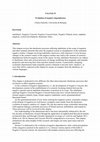
The Oxford Handbook of Negation, ed. by V. Déprez & M.T. Espinal, 2020
PRE-PRINT DRAFT
https://www.oxfordhandbooks.com/view/10.1093/oxfordhb/9780198830528.001.0001/o... more PRE-PRINT DRAFT
https://www.oxfordhandbooks.com/view/10.1093/oxfordhb/9780198830528.001.0001/oxfordhb-9780198830528-e-31
This chapter reviews the diachronic processes affecting indefinites in the scope of negation and other nominal elements that enter the negation system as strengtheners of the sentential negative marker. Changes involving indefinites interweave with Jespersen’s Cycle because changes in the syntactic nature of the negative marker may lead to the creation of syntactic dependencies between negative items in the clause. In turn, indefinites themselves are subject to diachronic clines and cyclical processes of change modifying their pragmatic and semantic properties and renewing their form and their featural content. A particularly intriguing systematic phenomenon leads originally positive elements to become more ‘negative’, in ways that will be explored in this chapter by means of examples from the diachrony of various languages.
The Oxford Handbook of Negation, ed. by V. Déprez & M.T. Espinal , 2020
PRE-PRINT DRAFT
https://www.oxfordhandbooks.com/view/10.1093/oxfordhb/9780198830528.001.0001/o... more PRE-PRINT DRAFT
https://www.oxfordhandbooks.com/view/10.1093/oxfordhb/9780198830528.001.0001/oxfordhb-9780198830528-e-4
This chapter is dedicated to the morpho-syntactic properties of markers of sentential negation, and to the relation between such properties and other aspects of the syntax of negation. It reviews the results of cross-linguistic research and describes the different forms of negative markers (affixes, particles, auxiliary verbs, complementizers). It also discusses a number of correlations between the form of the sentential negative marker and more general structural aspects (doubling, pre- vs. postverbal negation, presence of Negative Concord).
Chiara Gianollo & Elisabetta Magni (2019). Variation and change in Latin close appositions. Acta Antiqua Academiae Scientiarum Hungaricae, 59: 199-211.
CLUB Working Papers in Linguistics 3, 2019
La concordanza negativa è una strategia per esprimere la negazione di frase che si riscontra piut... more La concordanza negativa è una strategia per esprimere la negazione di frase che si riscontra piuttosto frequentemente nelle lingue. Le dimensioni di variazione individuate dagli studi tipologici pongono interessanti interrogativi dal punto di vista della teoria sintattica, in particolare per quanto riguarda la distinzione tra concordanza negativa simmetrica e asimmetrica. Il presente contributo rappresenta una riflessione su questi temi attraverso l’esame dei dati del greco classico, che è caratterizzato da un sistema asimmetrico con interessanti
peculiarità rispetto a quelli maggiormente studiati. Sulla base di questi dati, si propone un’interpretazione originale dei fattori che determinano l’esistenza della concordanza negativa asimmetrica.

Indefinites between Latin and Romance, 2018
Detailed Table of Contents for Chiara Gianollo 2018, "Indefinites between Latin and Romance", Oxf... more Detailed Table of Contents for Chiara Gianollo 2018, "Indefinites between Latin and Romance", Oxford: Oxford University Press.
This work follows the syntactic and semantic development of some indefinite pronouns and determiners between Latin and Romance. The history of elements of the functional lexicon such as Latin quidam ‘a certain’, aliquis ‘some’, nullus ‘no’, nemo ‘no one’, nihil ‘nothing’ allows us to detect which aspects of their meaning and of their form are responsible for the diachronic success of some of them, and for the disappearance of others, and how they are reanalyzed or replaced in the Romance languages. The system of indefinite pronouns and determiners changes profoundly from Latin to Romance, but Romance languages maintain a certain degree of similarity in the way their various systems evolve. We can account for this similarity of outcomes if we consider the changes happening at the intermediate stage of Late Latin. At this stage, the grammar of indefinites already shows a number of changes, which are homogeneously transmitted to the daughter languages, explaining in this way the parallelism among the various emerging Romance systems. The conclusions of this study confirm the fruitfulness of applying methods and models developed within synchronic theoretical linguistics to the study of diachronic phenomena. In turn, they bear witness to the importance of diachronic research for understanding the nature of crosslinguistic variation, and the systematic nature of language change.
https://www.oxfordscholarship.com/view/10.1093/oso/9780198812661.001.0001/oso-9780198812661
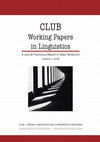
CLUB Working Papers in Linguistics, 2018
Mutamenti ciclici che coinvolgono la marca di negazione di frase sono ben noti e vanno tradiziona... more Mutamenti ciclici che coinvolgono la marca di negazione di frase sono ben noti e vanno tradizionalmente sotto il nome di Ciclo di Jespersen. In questo contributo si discutono alcuni dati dalla storia comparata delle lingue romanze (la nascita di nuovi indefiniti prefissati con la
particella di negazione "nec", gli esiti del latino "aliquis"), che mostrano che anche i pronomi e determinanti indefiniti sono soggetti a simili fenomeni di rinnovamento ciclico. Alla base di tali cicli si riscontrano analoghe pressioni funzionali: emerge come particolarmente rilevante a
questo proposito la tendenza pragmatica a sviluppare mezzi per l’espressione della negazione enfatica. Gli indefiniti, in quanto espressione di quantificazione esistenziale nella portata della
negazione, si qualificano come candidati ideali per l’espressione della negazione enfatica di frase. Grazie allo studio degli indefiniti si vedrà come questa pressione pragmatica basata sull’uso risulti, nel processo di mutamento, ancora più decisiva della tendenza a mantenere per
la negazione una realizzazione morfosintatticamente trasparente, tradizionalmente invocata come spiegazione per l’esistenza del Ciclo di Jespersen.
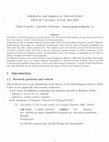
paper presented at DiGS 20, University of York, 20.6.2018, 2018
The history of Greek negation is interesting for our theoretical understanding of negation system... more The history of Greek negation is interesting for our theoretical understanding of negation systems in at least two respects, which I will investigate in this presentation:
(i) Homeric Greek is a Double Negation system, while Classical Greek exhibits Negative Concord. Homeric Greek already shows signs of a diachronic development: there are two series of negative indefinites, an older plain one and a newer emphatic one. The emphatic series is formed by means of the focus-sensitive correlative negation oudé. The latter is the only negatively marked element to exhibit redundancy in the marking of negation in Homeric Greek. My hypothesis is that this element is responsible for the birth of [uNeg] elements of Concord in the language.
(ii) Classical Greek is a non-strict Negative Concord language. However, differently from other well-studied languages of this type (e.g. Italian, Spanish, Portuguese), it shows extremely frequent cases of pre-Infl Concord among multiple [uNeg] items, a more constrained option in Romance. A study of their distribution may help shed light on the interaction between the syntax of Focus and Negative Concord.
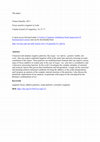
Catalan Journal of Linguistics (see link to download), 2017
Classical Latin displays negative particles, like neque / nec and ne…quidem 'neither, not even', ... more Classical Latin displays negative particles, like neque / nec and ne…quidem 'neither, not even', that can express sentential negation while at the same time narrowly focusing on some constituent of the clause. These particles are multifunctional elements that can express various types of focus (additive or scalar) and, in the case of neque / nec, also have a coordinative and a discourse-structuring function. In this work I investigate the complex interplay of semantic and syntactic factors that govern their distribution and interpretation. I single out the structural and meaning-related contextual conditions favoring the additive or the scalar interpretation, and I propose an analysis of the complex internal structure of the particles. I also discuss the diachronic implications of my analysis, in particular with respect to the role played by the Romance continuations of nec.
longer draft version of a paper submitted to the Proceedings of the 18th International Colloquium... more longer draft version of a paper submitted to the Proceedings of the 18th International Colloquium on Latin Linguistics, published on Pallas (https://pallas.revues.org/3757)
Dear fellow linguists, I am investigating the contexts of use of the indefinite item evolved from... more Dear fellow linguists, I am investigating the contexts of use of the indefinite item evolved from Latin aliquis ‘some’ in various Romance varieties: Italian alcuno / French aucun / Catalan algun, algú / Spanish alguien, algún, alguno / Portuguese alguém, algum. I would be grateful if native speakers of these varieties could help me by completing the questionnaire and e-mailing it back to me! I would also be happy to receive suggestions on how to improve the questionnaire.
Bringing together diachronic research from a variety of perspectives, this volume focuses on the ... more Bringing together diachronic research from a variety of perspectives, this volume focuses on the interplay of syntactic and semantic factors in language change – an issue recently brought into the focus of formal linguistics by grammaticalization theory as well as Minimalist diachronic syntax. The contributions draw on data from numerous Indo-European languages including Vedic Sanskrit, Middle Indic, Greek as well as English and German, and discuss a range of phenomena such as change in negation markers, indefinite
articles, quantifiers, modal verbs, argument structure among others. The papers analyze diachronic evidence in the light of contemporary syntactic and semantic theory, addressing the crucial question of how syntactic and semantic change are linked, and whether both are governed by similar constraints, principles and systematic mechanisms.
I examine the use of a special genitive construction to express inalienable possession in the Gre... more I examine the use of a special genitive construction to express inalienable possession in the Greek New Testament, and the strategies to translate it in the Latin Vulgate. The survey reveals a clash between various faithfulness criteria in translation, and presents the different reactions of the Latin translator, showing how discrepancies arise in a domain where the grammatical resources of the two languages sharply differ.









Uploads
Papers by Chiara Gianollo
un’interpretazione come ‘diverso’ da un’interpretazione come ‘ulteriore’. Il contributo si occupa di individuare
gli elementi del significato che danno origine a questa ambiguità e le condizioni contestuali che conducono
alla disambiguazione. La questione è affrontata per mezzo di un confronto tra la situazione del latino arcaico
e classico e la situazione che per l’italiano emerge dall’analisi di dati del parlato. L’analisi evidenzia la
presenza di un nucleo di tratti comuni a latino e italiano, che corrobora la pervasività della dimensione di
ambiguità oggetto di studio e pone le basi per un’indagine diacronica. I dati del parlato permettono, inoltre, di
studiare nel dettaglio i meccanismi inferenziali che mettono gli interlocutori in grado di gestire l’ambiguità e
di risolverla nel contesto.
In Italian, altro ‘other’ shows a dimension of ambiguity that has been little explored, according to which the
reading ‘different’ is distinguished from the reading ‘further’. This contribution singles out the meaning
elements that produce this ambiguity and the contextual conditions that lead to disambiguation. The issue is
approached by means of a comparison between the situation in Archaic and Classical Latin and the situation
that emerges from data of spoken Italian. The analysis highlights the presence of a core of features shared by
Latin and Italian, which corroborates the pervasive character of the investigated ambiguity and lays the
groundwork for a diachronic investigation. Furthermore, the data from spoken Italian enable a detailed study
of the inferential mechanisms that allow the speakers to manage ambiguity and resolve it in context.
The history of Greek negation is interesting for our theoretical understanding of negation systems in at least two respects, which I will investigate in this contribution. First, Homeric Greek is a Double Negation system, while Classical Greek exhibits Negative Concord.
Homeric Greek already shows signs of a diachronic development: there are two series of negative indefinites, an older plain one and a newer emphatic one. The emphatic series is formed by means of the focus-sensitive correlative negation oudé. The latter is the only negatively marked element to exhibit redundancy in the marking of negation in Homeric Greek: it can be argued to be responsible for the birth of Negative Concord items in the language. Furthermore, the system exhibited by Classical Greek is very relevant for our understanding of the syntactic factors that shape Negative Concord. Classical Greek is a non-strict Negative Concord language. However, differently from other well-studied languages of this type (e.g. Italian, Spanish, Portuguese), it shows extremely frequent cases of pre-Infl Concord among multiple Negative Concord items, a more constrained option in Romance. A study of their distribution may help shed light on the interaction between the syntax of Focus and Negative Concord.
Sempre più bambine e bambini, ragazze e ragazzi che frequentano la scuola italiana provengono da famiglie plurilingui; ciò significa che, nella loro quotidianità, si trovano a parlare e a interagire in altre lingue oltre all'italiano. Queste lingue non sempre trovano un adeguato spazio nella vita scolastica, dove talvolta vengono percepite come un ostacolo invece che come una risorsa. In realtà, il plurilinguismo, se adeguatamente compreso e valorizzato, rappresenta una grande ricchezza non solo per i singoli individui, ma anche per l'intera classe: l'importante è che le diverse lingue possano trovare un ambiente favorevole allo scambio e alla conoscenza reciproca. Questo volume ha lo scopo di fornire a insegnanti e educatori di persone plurilingui uno strumento per conoscere più da vicino le altre lingue dei loro allievi. Brevi capitoli descrivono le lingue straniere maggiormente parlate nelle scuole italiane, offrendo informazioni sulla loro storia e sulle loro caratteristiche, in un linguaggio accessibile e con frequenti rimandi contrastivi alla struttura dell'italiano. Gli spunti che si possono trarre dai contributi sulle diverse lingue serviranno a progettare non solo attività di potenziamento linguistico individuale per i nuovi arrivati, ma anche esperienze didattiche inclusive che guidino gli allievi nell'esplorazione della realtà che li circonda, osservata attraverso il prisma del plurilinguismo.
https://www.oxfordhandbooks.com/view/10.1093/oxfordhb/9780198830528.001.0001/oxfordhb-9780198830528-e-31
This chapter reviews the diachronic processes affecting indefinites in the scope of negation and other nominal elements that enter the negation system as strengtheners of the sentential negative marker. Changes involving indefinites interweave with Jespersen’s Cycle because changes in the syntactic nature of the negative marker may lead to the creation of syntactic dependencies between negative items in the clause. In turn, indefinites themselves are subject to diachronic clines and cyclical processes of change modifying their pragmatic and semantic properties and renewing their form and their featural content. A particularly intriguing systematic phenomenon leads originally positive elements to become more ‘negative’, in ways that will be explored in this chapter by means of examples from the diachrony of various languages.
https://www.oxfordhandbooks.com/view/10.1093/oxfordhb/9780198830528.001.0001/oxfordhb-9780198830528-e-4
This chapter is dedicated to the morpho-syntactic properties of markers of sentential negation, and to the relation between such properties and other aspects of the syntax of negation. It reviews the results of cross-linguistic research and describes the different forms of negative markers (affixes, particles, auxiliary verbs, complementizers). It also discusses a number of correlations between the form of the sentential negative marker and more general structural aspects (doubling, pre- vs. postverbal negation, presence of Negative Concord).
peculiarità rispetto a quelli maggiormente studiati. Sulla base di questi dati, si propone un’interpretazione originale dei fattori che determinano l’esistenza della concordanza negativa asimmetrica.
This work follows the syntactic and semantic development of some indefinite pronouns and determiners between Latin and Romance. The history of elements of the functional lexicon such as Latin quidam ‘a certain’, aliquis ‘some’, nullus ‘no’, nemo ‘no one’, nihil ‘nothing’ allows us to detect which aspects of their meaning and of their form are responsible for the diachronic success of some of them, and for the disappearance of others, and how they are reanalyzed or replaced in the Romance languages. The system of indefinite pronouns and determiners changes profoundly from Latin to Romance, but Romance languages maintain a certain degree of similarity in the way their various systems evolve. We can account for this similarity of outcomes if we consider the changes happening at the intermediate stage of Late Latin. At this stage, the grammar of indefinites already shows a number of changes, which are homogeneously transmitted to the daughter languages, explaining in this way the parallelism among the various emerging Romance systems. The conclusions of this study confirm the fruitfulness of applying methods and models developed within synchronic theoretical linguistics to the study of diachronic phenomena. In turn, they bear witness to the importance of diachronic research for understanding the nature of crosslinguistic variation, and the systematic nature of language change.
https://www.oxfordscholarship.com/view/10.1093/oso/9780198812661.001.0001/oso-9780198812661
particella di negazione "nec", gli esiti del latino "aliquis"), che mostrano che anche i pronomi e determinanti indefiniti sono soggetti a simili fenomeni di rinnovamento ciclico. Alla base di tali cicli si riscontrano analoghe pressioni funzionali: emerge come particolarmente rilevante a
questo proposito la tendenza pragmatica a sviluppare mezzi per l’espressione della negazione enfatica. Gli indefiniti, in quanto espressione di quantificazione esistenziale nella portata della
negazione, si qualificano come candidati ideali per l’espressione della negazione enfatica di frase. Grazie allo studio degli indefiniti si vedrà come questa pressione pragmatica basata sull’uso risulti, nel processo di mutamento, ancora più decisiva della tendenza a mantenere per
la negazione una realizzazione morfosintatticamente trasparente, tradizionalmente invocata come spiegazione per l’esistenza del Ciclo di Jespersen.
(i) Homeric Greek is a Double Negation system, while Classical Greek exhibits Negative Concord. Homeric Greek already shows signs of a diachronic development: there are two series of negative indefinites, an older plain one and a newer emphatic one. The emphatic series is formed by means of the focus-sensitive correlative negation oudé. The latter is the only negatively marked element to exhibit redundancy in the marking of negation in Homeric Greek. My hypothesis is that this element is responsible for the birth of [uNeg] elements of Concord in the language.
(ii) Classical Greek is a non-strict Negative Concord language. However, differently from other well-studied languages of this type (e.g. Italian, Spanish, Portuguese), it shows extremely frequent cases of pre-Infl Concord among multiple [uNeg] items, a more constrained option in Romance. A study of their distribution may help shed light on the interaction between the syntax of Focus and Negative Concord.
articles, quantifiers, modal verbs, argument structure among others. The papers analyze diachronic evidence in the light of contemporary syntactic and semantic theory, addressing the crucial question of how syntactic and semantic change are linked, and whether both are governed by similar constraints, principles and systematic mechanisms.
un’interpretazione come ‘diverso’ da un’interpretazione come ‘ulteriore’. Il contributo si occupa di individuare
gli elementi del significato che danno origine a questa ambiguità e le condizioni contestuali che conducono
alla disambiguazione. La questione è affrontata per mezzo di un confronto tra la situazione del latino arcaico
e classico e la situazione che per l’italiano emerge dall’analisi di dati del parlato. L’analisi evidenzia la
presenza di un nucleo di tratti comuni a latino e italiano, che corrobora la pervasività della dimensione di
ambiguità oggetto di studio e pone le basi per un’indagine diacronica. I dati del parlato permettono, inoltre, di
studiare nel dettaglio i meccanismi inferenziali che mettono gli interlocutori in grado di gestire l’ambiguità e
di risolverla nel contesto.
In Italian, altro ‘other’ shows a dimension of ambiguity that has been little explored, according to which the
reading ‘different’ is distinguished from the reading ‘further’. This contribution singles out the meaning
elements that produce this ambiguity and the contextual conditions that lead to disambiguation. The issue is
approached by means of a comparison between the situation in Archaic and Classical Latin and the situation
that emerges from data of spoken Italian. The analysis highlights the presence of a core of features shared by
Latin and Italian, which corroborates the pervasive character of the investigated ambiguity and lays the
groundwork for a diachronic investigation. Furthermore, the data from spoken Italian enable a detailed study
of the inferential mechanisms that allow the speakers to manage ambiguity and resolve it in context.
The history of Greek negation is interesting for our theoretical understanding of negation systems in at least two respects, which I will investigate in this contribution. First, Homeric Greek is a Double Negation system, while Classical Greek exhibits Negative Concord.
Homeric Greek already shows signs of a diachronic development: there are two series of negative indefinites, an older plain one and a newer emphatic one. The emphatic series is formed by means of the focus-sensitive correlative negation oudé. The latter is the only negatively marked element to exhibit redundancy in the marking of negation in Homeric Greek: it can be argued to be responsible for the birth of Negative Concord items in the language. Furthermore, the system exhibited by Classical Greek is very relevant for our understanding of the syntactic factors that shape Negative Concord. Classical Greek is a non-strict Negative Concord language. However, differently from other well-studied languages of this type (e.g. Italian, Spanish, Portuguese), it shows extremely frequent cases of pre-Infl Concord among multiple Negative Concord items, a more constrained option in Romance. A study of their distribution may help shed light on the interaction between the syntax of Focus and Negative Concord.
Sempre più bambine e bambini, ragazze e ragazzi che frequentano la scuola italiana provengono da famiglie plurilingui; ciò significa che, nella loro quotidianità, si trovano a parlare e a interagire in altre lingue oltre all'italiano. Queste lingue non sempre trovano un adeguato spazio nella vita scolastica, dove talvolta vengono percepite come un ostacolo invece che come una risorsa. In realtà, il plurilinguismo, se adeguatamente compreso e valorizzato, rappresenta una grande ricchezza non solo per i singoli individui, ma anche per l'intera classe: l'importante è che le diverse lingue possano trovare un ambiente favorevole allo scambio e alla conoscenza reciproca. Questo volume ha lo scopo di fornire a insegnanti e educatori di persone plurilingui uno strumento per conoscere più da vicino le altre lingue dei loro allievi. Brevi capitoli descrivono le lingue straniere maggiormente parlate nelle scuole italiane, offrendo informazioni sulla loro storia e sulle loro caratteristiche, in un linguaggio accessibile e con frequenti rimandi contrastivi alla struttura dell'italiano. Gli spunti che si possono trarre dai contributi sulle diverse lingue serviranno a progettare non solo attività di potenziamento linguistico individuale per i nuovi arrivati, ma anche esperienze didattiche inclusive che guidino gli allievi nell'esplorazione della realtà che li circonda, osservata attraverso il prisma del plurilinguismo.
https://www.oxfordhandbooks.com/view/10.1093/oxfordhb/9780198830528.001.0001/oxfordhb-9780198830528-e-31
This chapter reviews the diachronic processes affecting indefinites in the scope of negation and other nominal elements that enter the negation system as strengtheners of the sentential negative marker. Changes involving indefinites interweave with Jespersen’s Cycle because changes in the syntactic nature of the negative marker may lead to the creation of syntactic dependencies between negative items in the clause. In turn, indefinites themselves are subject to diachronic clines and cyclical processes of change modifying their pragmatic and semantic properties and renewing their form and their featural content. A particularly intriguing systematic phenomenon leads originally positive elements to become more ‘negative’, in ways that will be explored in this chapter by means of examples from the diachrony of various languages.
https://www.oxfordhandbooks.com/view/10.1093/oxfordhb/9780198830528.001.0001/oxfordhb-9780198830528-e-4
This chapter is dedicated to the morpho-syntactic properties of markers of sentential negation, and to the relation between such properties and other aspects of the syntax of negation. It reviews the results of cross-linguistic research and describes the different forms of negative markers (affixes, particles, auxiliary verbs, complementizers). It also discusses a number of correlations between the form of the sentential negative marker and more general structural aspects (doubling, pre- vs. postverbal negation, presence of Negative Concord).
peculiarità rispetto a quelli maggiormente studiati. Sulla base di questi dati, si propone un’interpretazione originale dei fattori che determinano l’esistenza della concordanza negativa asimmetrica.
This work follows the syntactic and semantic development of some indefinite pronouns and determiners between Latin and Romance. The history of elements of the functional lexicon such as Latin quidam ‘a certain’, aliquis ‘some’, nullus ‘no’, nemo ‘no one’, nihil ‘nothing’ allows us to detect which aspects of their meaning and of their form are responsible for the diachronic success of some of them, and for the disappearance of others, and how they are reanalyzed or replaced in the Romance languages. The system of indefinite pronouns and determiners changes profoundly from Latin to Romance, but Romance languages maintain a certain degree of similarity in the way their various systems evolve. We can account for this similarity of outcomes if we consider the changes happening at the intermediate stage of Late Latin. At this stage, the grammar of indefinites already shows a number of changes, which are homogeneously transmitted to the daughter languages, explaining in this way the parallelism among the various emerging Romance systems. The conclusions of this study confirm the fruitfulness of applying methods and models developed within synchronic theoretical linguistics to the study of diachronic phenomena. In turn, they bear witness to the importance of diachronic research for understanding the nature of crosslinguistic variation, and the systematic nature of language change.
https://www.oxfordscholarship.com/view/10.1093/oso/9780198812661.001.0001/oso-9780198812661
particella di negazione "nec", gli esiti del latino "aliquis"), che mostrano che anche i pronomi e determinanti indefiniti sono soggetti a simili fenomeni di rinnovamento ciclico. Alla base di tali cicli si riscontrano analoghe pressioni funzionali: emerge come particolarmente rilevante a
questo proposito la tendenza pragmatica a sviluppare mezzi per l’espressione della negazione enfatica. Gli indefiniti, in quanto espressione di quantificazione esistenziale nella portata della
negazione, si qualificano come candidati ideali per l’espressione della negazione enfatica di frase. Grazie allo studio degli indefiniti si vedrà come questa pressione pragmatica basata sull’uso risulti, nel processo di mutamento, ancora più decisiva della tendenza a mantenere per
la negazione una realizzazione morfosintatticamente trasparente, tradizionalmente invocata come spiegazione per l’esistenza del Ciclo di Jespersen.
(i) Homeric Greek is a Double Negation system, while Classical Greek exhibits Negative Concord. Homeric Greek already shows signs of a diachronic development: there are two series of negative indefinites, an older plain one and a newer emphatic one. The emphatic series is formed by means of the focus-sensitive correlative negation oudé. The latter is the only negatively marked element to exhibit redundancy in the marking of negation in Homeric Greek. My hypothesis is that this element is responsible for the birth of [uNeg] elements of Concord in the language.
(ii) Classical Greek is a non-strict Negative Concord language. However, differently from other well-studied languages of this type (e.g. Italian, Spanish, Portuguese), it shows extremely frequent cases of pre-Infl Concord among multiple [uNeg] items, a more constrained option in Romance. A study of their distribution may help shed light on the interaction between the syntax of Focus and Negative Concord.
articles, quantifiers, modal verbs, argument structure among others. The papers analyze diachronic evidence in the light of contemporary syntactic and semantic theory, addressing the crucial question of how syntactic and semantic change are linked, and whether both are governed by similar constraints, principles and systematic mechanisms.